QLD teenager discovers deadly snake in little sister’s bedroom
One big brother had a lucky escape after the Queensland teenager found a deadly brown snake taking a tour of his four-year-old sister’s bedroom – don’t miss our snake guide and safety tips
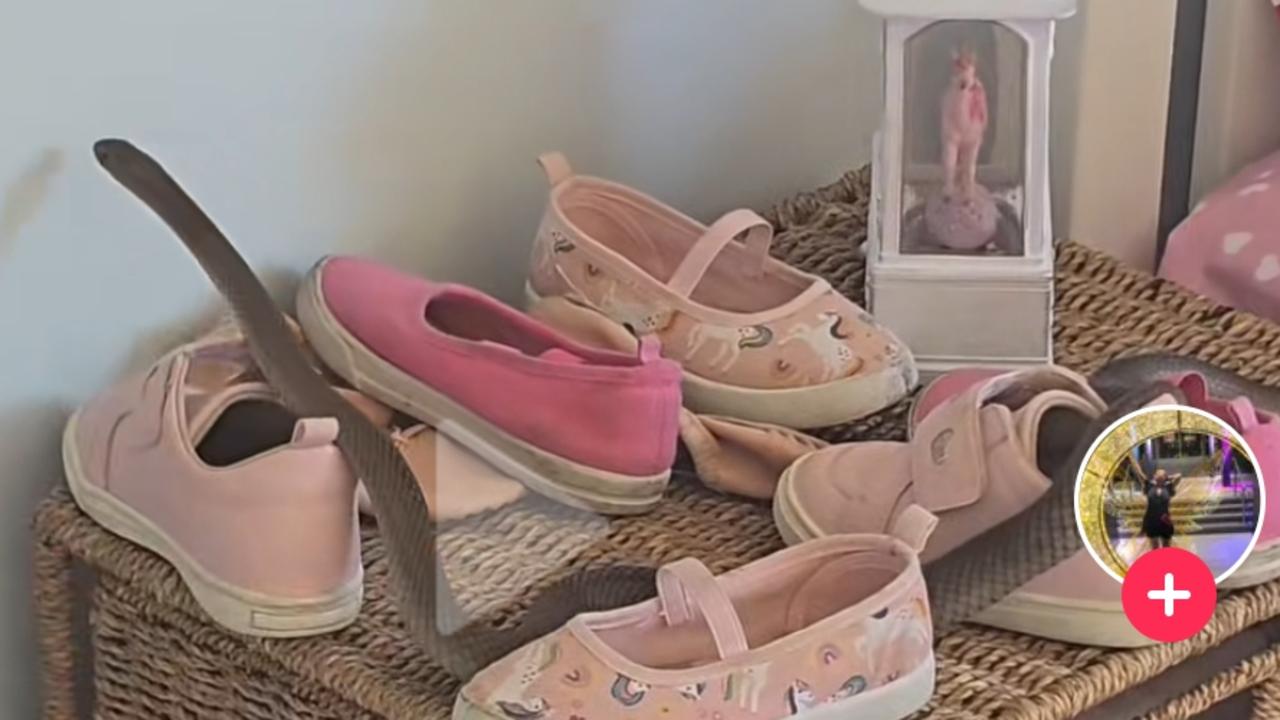
READING LEVEL: GREEN
Being home alone turned out to be a lot less fun than expected for one Queensland teen, after he found a deadly eastern brown snake had slithered into his four-year-old sister’s bedroom.
In a video uploaded to TikTok, mum Renée Pallister filmed the snake as it slid its way across her daughter’s collection of pink shoes.
“Not exactly what you want to find in your baby’s room when you come home,” she said in the video. “It likes pink shoes. It’s quite a long snake.”
Ms Pallister revealed that her teenage son had luckily discovered the reptile while home sick from school.
“My son was sick and found it first. I was at work and drove home,” she wrote in the comments section.
“Lucky he was home otherwise my four-year-old daughter would have been the first in her room. Terrifying.”

Ms Pallister had the snake removed by a professional snake handler. Still calming down after her family’s close encounter, she joked on TikTok that she still had a case of “snake PTSD*”.
“I haven’t been able to sleep much,” she replied to one commenter.
“Even though the snake was removed I still keep waking up and checking my daughter’s room.”
After discovering her slippery, uninvited house guest, Ms Pallister searched the room for snake entry points.
“This one got in by a small hole that went unnoticed,” she wrote.
“We have patched it up now.”
While some commenters expressed concern, others were amused by the snake’s taste in shoes.
“Took me a minute to notice the snake. I don’t know why I was fixated* on the shoes,” one wrote.
“He likes pink shoes but doesn’t have any feet,” another added.
Ms Pallister said the snake was also a huge children’s literary fan, knocking over multiple books from the bookshelf while inside the bedroom.
SNAKE SEASON SAFETY
With snake season running in the warmer months from September through to April, all Australians needs to take extra care. Always avoid approaching or touching a snake if you do encounter one – it is always safest to assume it is venomous.
Professional snake handlers and health authorities strongly recommend that people – especially children – exercise caution and common sense at all times.
Please do not attempt to engage directly with a snake unless it is in a controlled environment with a professional snake handler.
If you come face-to-face with a snake, please alert an adult immediately. Here’s what to do if you are unlucky enough to be bitten.
AUSTRALIA’S MOST DANGEROUS SNAKES
Snakes are amazing creatures and Australia is home to both venomous and non-venomous varieties. They play essential roles in the ecosystem* – but here’s identifying information in descending order from the Australian Museum about the nation’s Top 10 snakes to avoid (unless they’re safely behind glass at your local zoo).
10. Red-bellied black snake (Pseudechis porphyriacus)
Where: The east coast (except Tasmania) and just into southeastern South Australia.
Identification: A medium-sized snake, with a moderate to robust build and head barely distinct from the neck. Dorsal* head and body colour is uniform black, except for the snout, which is often pale brown. The lowest lateral* scale rows and the outer edge of the ventral* scales are bright crimson, fading to duller red, orange or pink in the middle of the belly. In the north of the range the ventral colour may be greyish-pink to white. The underside of the tail is black.
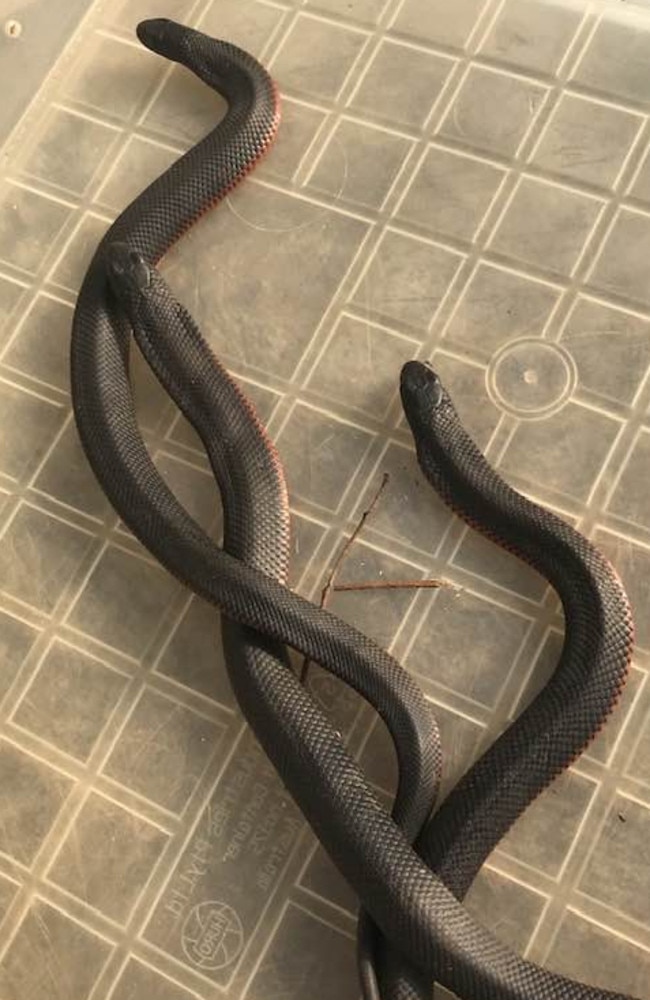
While less venomous than many other Australian snakes, it’s more likely to be in urban areas.
Red-bellied blacks are one of the few large venomous snakes still found in the Sydney region, and at 2m long, can eat other snakes.
They are not particularly aggressive and will escape from humans if possible, but when threatened will flatten their bodies and hiss loudly.
No deaths have been confirmed from bites by this species.
9. Common death adder (Acanthophis antarcticus)
Where: Eastern Australia – except the far north and south – and southern South Australia and Western Australia.
Identification: The Common death adder is easily recognised by its triangular-shaped head, short stout body and thin tail.
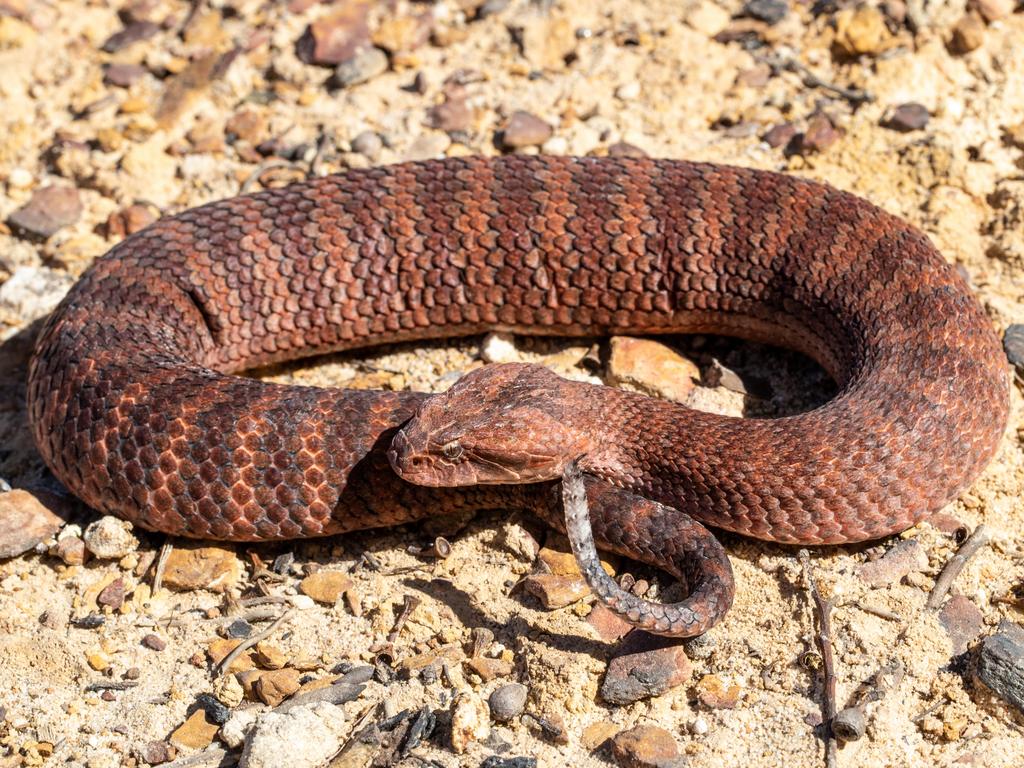
An ambush* predator* that hides motionless, then twitching the wormlike lure on the end of its tail to attract prey.
Unlike other snakes that flee from humans, these snakes are more likely to risk being trodden on, making them more dangerous.
About half of death adder bites were previously fatal, before the introduction of antivenom.
8. Small-eyed snake (Rhinoplocephalus nigrescens)
Where: Along the east coast from Victoria to Cape York.
Identification: A small to moderately-sized species. The head is slightly flattened and barely distinct from the solid body. The back, sides and top of the head and body are steely blue-black. The ventral colour ranges from cream (in the south) to bright coral pink (in the north), and is often flecked or blotched with black.

At about 50cm-long, these snakes still pack a punch.
Though common, small-eyed snakes largely come out at night and therefore often avoid humans.
When disturbed they may thrash about aggressively, but are not usually inclined to bite.
7. Lowlands copperhead (Austrelaps superbus)
Where: In cold climates in southern Victoria, Tasmania and the islands of Bass Strait.
Identification: All species of copperheads are fairly similar in general form and colouration. They are moderately robust and muscular in build. The scales of the back and upper sides are semi-glossy and uniformly blackish to grey brown in colour, with a brownish or orange flush in some individuals of lowland and highland copperheads. The lowermost rows of lateral scales are enlarged and these are usually a paler colour, particularly on the neck and forebode.

The only venomous snake found above the snow line, they are active in weather that’s usually too cold for snakes.
Copperheads are shy and avoid people, though they live in populated and agricultural areas.
When cornered they hiss loudly, flatten their body and thrash about.
6. Mulga snake (Pseudechis australis)
Where: Across most of Australia except Victoria, Tasmania and southern parts of Western Australia.
Identification: Juvenile* snakes may be of average build but adults are usually quite robust, with a broad deep head and bulbous cheeks. The scales on the back, sides and tail are usually two-toned; a darker colour covers the distal* portion of the scale to various degrees (from just the very tip to almost the entire scale) and may be brown, reddish brown, coppery brown or brownish black.
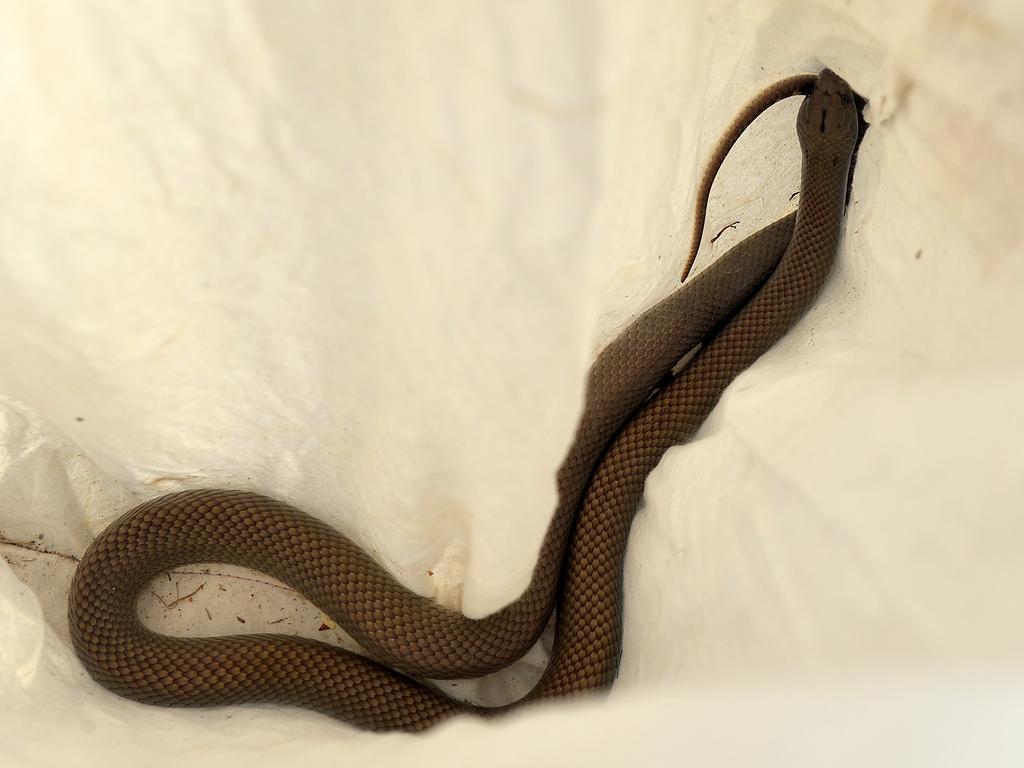
The mulga is the heaviest venomous snake in Australia and has the largest-recorded venom output of any in the world, delivering 150mg in one bite.
Southern mulgas are said to be shy; northern specimens are much more aggressive if disturbed.
Mulgas bite savagely, even hanging on as they inject large amounts of highly toxic venom, which destroys blood cells and affects the muscles and nerves.
5. Coastal taipan (Oxyuranus scutellatus)
Where: Along the east coast from northern NSW to Brisbane in QLD, and northern Western Australia.
Identification: A medium to large snake, with a robust build and a deep, rectangular-shaped head distinct from the slender neck. Body colour may be yellowish, reddish brown, dark brown or almost black. The species undergoes a seasonal change in colour, with individuals becoming darker in winter and fading in summer.

Coastal taipans have the longest fangs of any Australian snake (13mm), and have the third most toxic venom of any land snakes.
They are known to put up a strong defence when surprised or cornered.
However, generally they are not confrontational and usually flee before fighting.
4. Inland taipan (Oxyuranus microlepidotus)
Where: In cracks on dry plains where the QLD, South Australia, NSW and Northern Territory borders meet.
Identification: A medium to large snake, with a robust build and a deep, rectangular-shaped head. Dorsal colour varies from pale fawn to yellowish-brown to dark brown, with the head and neck being several to many shades darker than the body. Colour changes seasonally, with individuals becoming darker in winter and fading in summer.
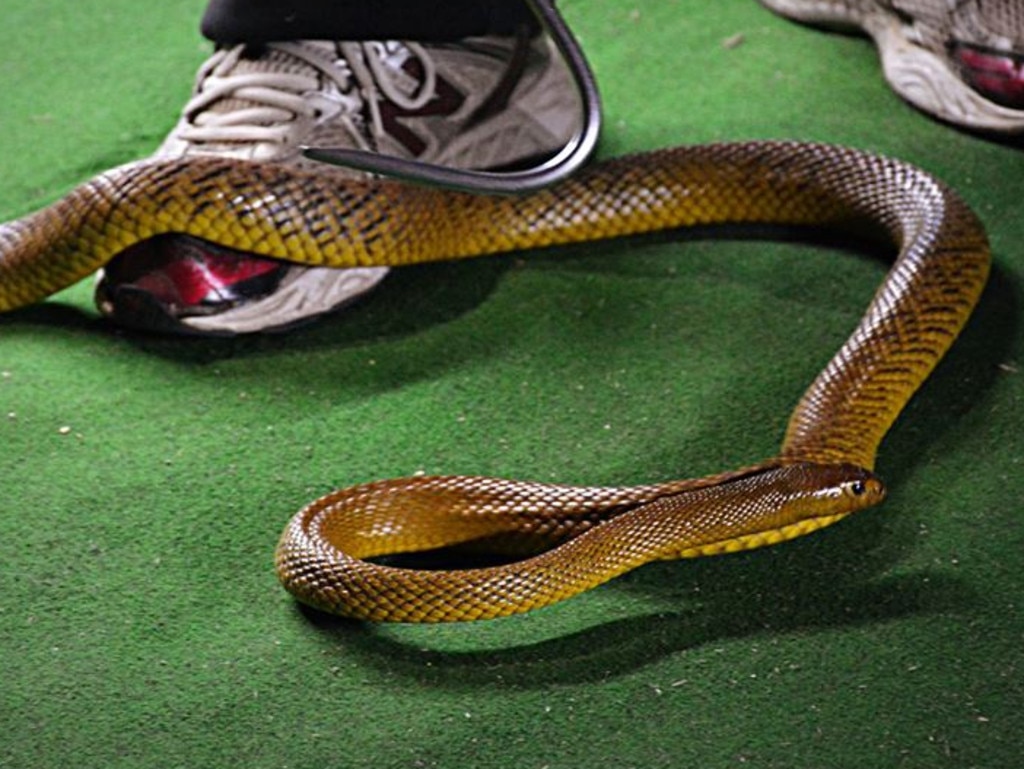
Also known as the fierce snake or small-scaled snake, inland taipans hide in remote areas.
Nonetheless, its highly toxic venom is considered the most potent of any land snake in the world.
Hunting in the confined space of the burrows of the long-haired rat, the inland taipan uses its deadly venom to finish off prey quickly.
3. Mainland tiger snake (Notechis scutatus)
Where: NSW, Tasmania, Victoria and the far corner of South Australia.
Identification: The Common name refers to the prominent yellow and black cross-bands typical of some populations of tiger snakes, however not all have this pattern. The most commonly seen form is dark olive brown to blackish-brown, with off-white to yellowish cross-bands that can vary in thickness.

Due to the areas they live in, mainland tiger snakes are responsible for the second-highest number of snake bites in Australia.
They are attracted to farms and outer suburban houses, hunting mice at night.
Bites are fatal if untreated, causing pain in the feet and neck, tingling, numbness and sweating, followed by breathing difficulties and paralysis.
2. Western brown snake (Pseudonaja nuchalis)
Where: Over most of mainland Australia, except for the wetter fringes of eastern Australia and southwestern Western Australia.
Identification: A long and slender snake, with a smallish head indistinct from the neck. When viewed from above the snout has a chisel-shaped appearance due in part to the enlarged straplike rostral* scale. Scales are smooth and semi-glossy, often very glossy around the head and neck.
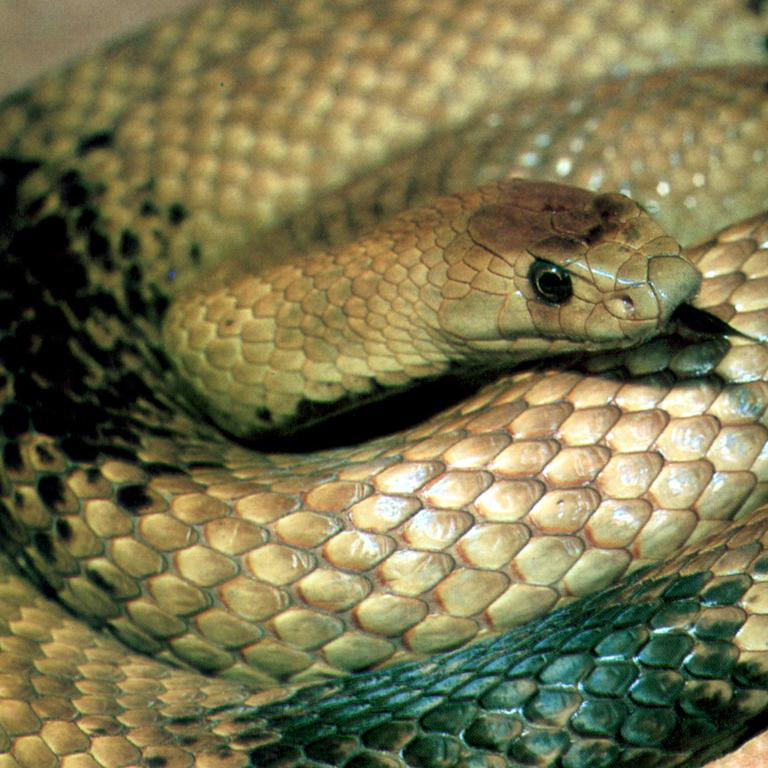
Also known as “gwardar”, it is thought to be less aggressive than its eastern cousin but is still highly dangerous.
When disturbed they will run for cover, striking quickly if cornered, then making a quick getaway.
Though their venom is not as toxic as the eastern brown’s, they deliver three times as much. Bites are usually painless and difficult to see.
1. Eastern brown snake (Pseudonaja textilis)
Where: Mainly the eastern half of mainland Australia
Identification: A medium-sized snake, with a slender to moderate build and a smallish head barely distinct from the neck. Body colour may be almost any shade of brown, ranging from near black to light tan, chestnut or burnt-orange.
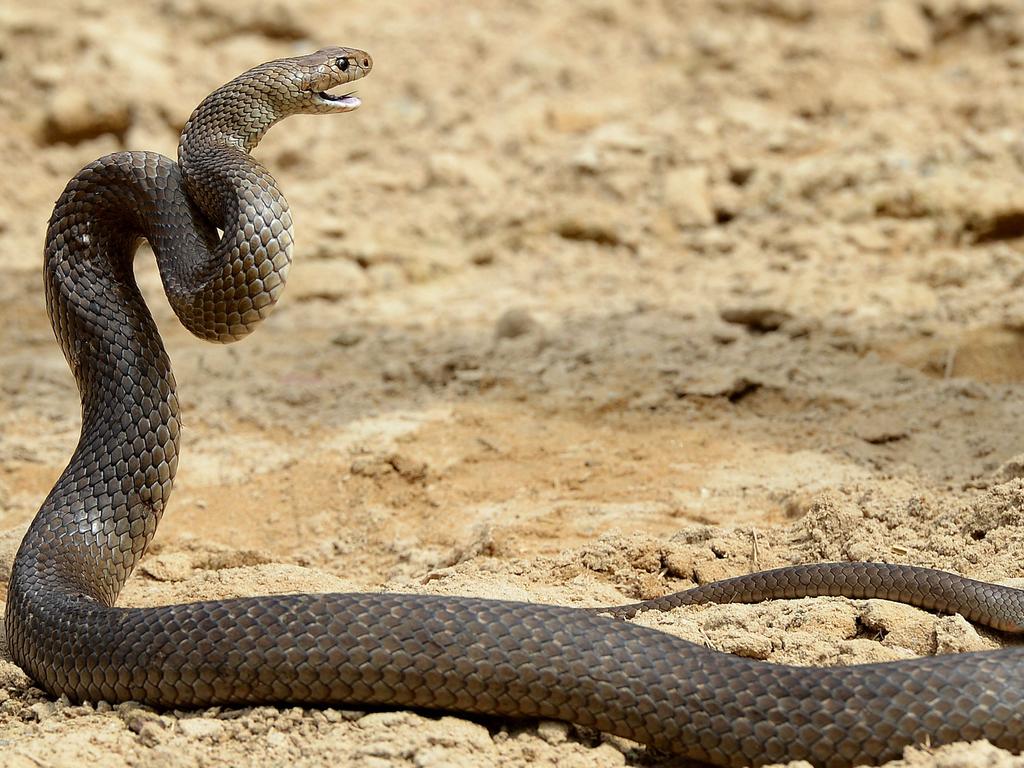
Also known as a common brown snake, these snakes are quick, aggressive and bad tempered.
Along with other browns, they are responsible for more deaths every year in Australia than any other group of snakes.
Their venom is the second most toxic of any land snake in the world and they thrive in populated areas, particularly on farms.
If disturbed, it raises its body off the ground in an “S” shape, with its mouth open.
POLL
GLOSSARY
- PTSD: post traumatic stress disorder, caused by an extremely stressful or frightening event
- fixated: unable to stop thinking about something
- ecosystem: a geographic area where plants, animals, and other organisms, as well as weather and landscapes, all work together to sustain life
- dorsal: on or near the back of an animal
- lateral: along the sides
- ventral: near, on or toward the belly
- ambush: surprise attack after hiding and waiting
- predator: animal that survives by killing and eating other animals
- juvenile: young, not yet fully grown into adulthood
- rostral: towards the nose, beak or snout of an animal
EXTRA READING
Male snakes’ wild ‘wrestling match’
Bird versus snake – who will win?
Snake girl conquers carpet python
QUICK QUIZ
- What kind of snake was found in the girl’s bedroom?
- Who discovered the snake?
- How did the snake enter the bedroom?
- Who removed the snake?
- Aside from slithering across the collection of shoes, the snake also disturbed a collection of what kind of item?
LISTEN TO THIS STORY
CLASSROOM ACTIVITIES
1. Snakes of Australia
Plot the top ten deadliest snakes in Australia on the blank map below.
Which state has the most dangerous snakes?
Why do you think this is?

Time: allow 15 minutes to complete this activity
Curriculum Links: English, Geography, Personal and Social, Critical and Creative Thinking
2. Extension
What do you know about snakes and the essential role they play in the ecosystem? Talk to a classmate and see if you can add to your knowledge.
Time: allow 10 minutes to complete this activity
Curriculum Links: English, Science, Personal and Social, Critical and Creative Thinking
VCOP ACTIVITY
Adjectives
An adjective is a describing word. They are often found describing a noun. Start by looking at the words before the nouns.
Search for all the adjectives you can find in the article.
Did you find any repeat adjectives or are they all different?
Extension:
Pick three of your favourite adjectives from the text and put them in your own sentences to show other ways to use them.
Have you used any in your writing?

